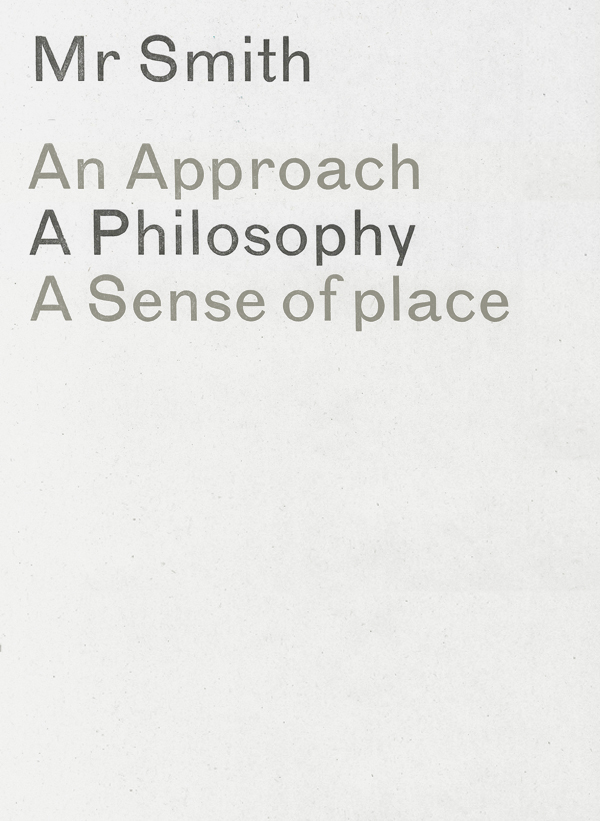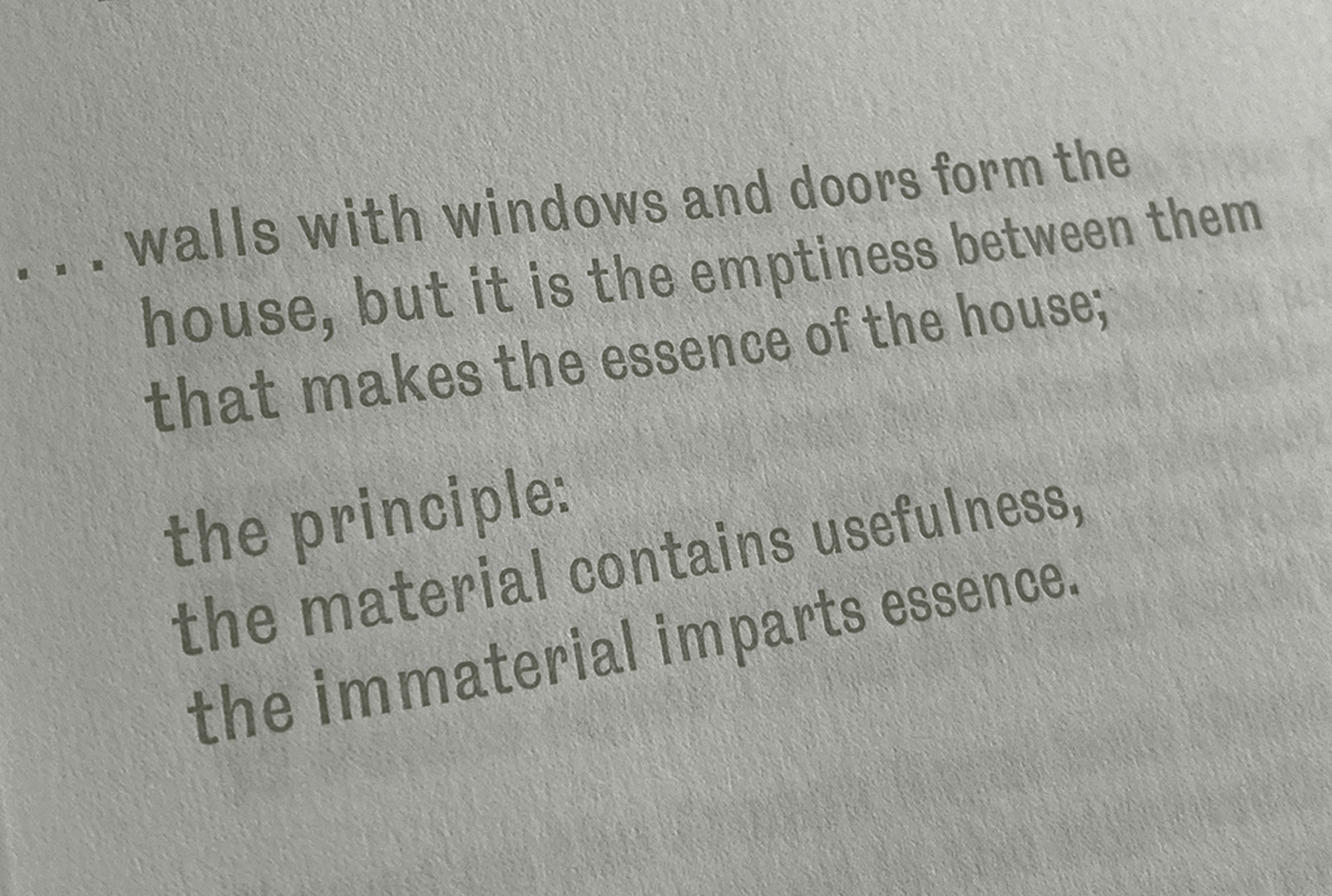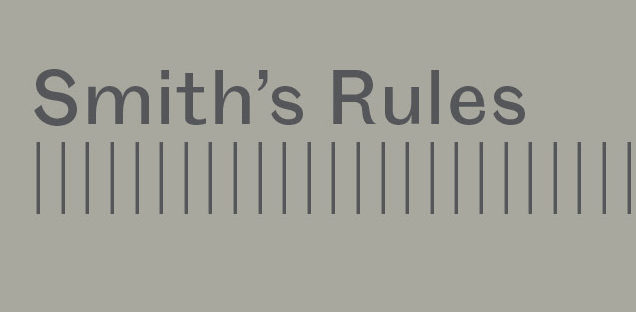



01.2 / Mr Smith / A Philosophy

Smith’s Rules*
—00
Smith’s Rules should be followed wherever practicable. Exceptions can be made for narrow minds and when the rearrangement of ideas to conform with these rules would prove unreasonable.
—00.1
Smith’s Rules is an ongoing series of ideas concerned with standards and attitudes towards the subject of visual communication.
—00.2
Smith’s Rules intention is to observe and address existing standards of visual language and their graphic representation.
—00.3
Smith’s Rules should offer the opportunity for the reader to contemplate their own ideas and reconsider their philosophical approach
Education: A Practical Guide for Amateurs
First Published in Grafik Magazine: ‘Experience’ Issue 2005
01
“The many-sided questions of design can only be answered adequately with experience and it may therefore be necessary, in your early years . . . to call upon the experience of others. ”
This austere insight — top-sliced from John Ryder’s penultimate chapter: ‘Sources of Inspiration’ in his 1955 exacting (gem of a) publication ’Printing for Pleasure’; A Practical Guide for Amateurs — affords an opportunity to reflect upon those whose experience we have once called upon.
02
Mr Ryder’s ‘little’* book is filled with elegant philosophical advice — certainly only ever accumulated through a lifetimes experience submerged in one’s subject. The author articulates his ideas and ideals through simple grammatical and linguistic precision. Combining the direct earnest optimism of post-war 1950’s Britain, with a vast knowledge, learned study and a startling passion for the subject; he ignites the premise that this ‘amateur undertaking’ is for pleasure of the experience; its intrinsic value is in the process and the pleasure of undertaking the process.
03
Discovered discarded in the Letterpress workshop at Northumbria University, the book instantly struck a cord with me. This slim and modest volume echoed my own philosophy of both printing and teaching: that pleasure should be the guiding principle behind both. Perhaps surprisingly Mr Ryder’s views match contemporary educational thinking; certainly that process is the central activity of learning and more radically that the guidelines of an experienced tutor/mentor are not prescriptive, but offered to ‘the student’ to discover through their own practice and application.
04
My proposition here is simply that students of Graphic Design should follow Mr Ryder’s advice and consider themselves ‘amateur’.
05
As an amateur your activity is not rewarded financially, but rather by pleasure, knowledge and experience. Therefore the emphasis is on actual process; both physical and intellectual; rather than final reward. As Mr Ryder suggests; amateur status affords [the student] the opportunity to embrace experimentation and exploration through process: the process that John Maeda now defines as ‘the core’.
06
In the early 1990’s; when I first began teaching at Middlesex University I was quietly sifting through the remarkable Cat Hill library boxed collection of the English ‘Form’ magazine when a slip of photocopied (A7) paper fell to the ground; on it was printed in capitals ‘Erratum Slip’; then underneath in smaller upper and lower case default Helvetica type; ‘In all cases: for: Art, read: Science’. This discovery prompted contemplation of the framework that underpins any subject. It offered me the opportunity to reflect upon my own Graphic Design teaching and reinforce the importance of discovery through process; as Maeda’s “the core is the process that informs the final outcome”.
07
Process and pleasure then should be the domain of the amateur. The two are certainly linked and indeed give life to each other as Mr Ryder intimates; “I think I may say with reasonable certainty that you have only to get a little printer’s ink on your hands (to be initiated into the practice of printing) to find that the ink sinks in to your veins and gives you a new approach to type and the printed page.”
08
It is not the job of the design educator to find a student a position; that is for the student; it is to inspire them to engage in their subject, nurture their interest and encourage, stimulate and liberate their inquisitive mind.
09
I would like to call upon all of you to derive the pleasure from that which you practice: use your experience; embrace your amateur status; and bear in mind a few of Mr Ryder’s insightful offerings:
In all cases:
for: Printing,
read: Education.
09.1 Approach
“Moreover it is not only the ‘kind ‘of printing but the also the ‘attitude’ of the printer which determines whether this activity shall be profit-making drudgery or a pleasurable pastime. I think you should dispense with any idea of running a small press as money making sideline. In the first place to do so would at once put you under obligation to your customers. You may be forced to produce things with which you have little or no sympathy and become involved in the labyrinth of keeping accounts. It would be far better to use your equipment as an instrument of design, to give your designs freely and to take friendship in return. If your growing circle of friends does not quickly convince you of the value of this attitude you may be sure you are mis-spending your leisure and that your talent lies elsewhere.”
09.2 Temperament
“It would be well to examine your temperament before seriously committing yourself . . . If possible do without assistance, financial or otherwise, and retain complete control over materials, style and output.”
09.3 Orderliness
“Before you consider taking up printing as a pastime there is a very important question to be answered. It relates to a characteristic of printing practice, namely orderliness. Without this printing cannot be carried out successfully. Once it is understood that, even to begin with, you will probably be using somewhere between 800 and 1 000 different characters, you will realise the necessity of keeping strict order. If you do not ‘mind your p’s and q’s’ throughout this large range of characters, confusion will bring your enterprise to a standstill. Keeping order is a simple procedure only if you recognise that it is essential. It is because this sense of order maybe lacking in, or be abhorrent to, some people that I issue the warning . . . if orderliness runs counter to your temperament then beware of printing types.”
* The introduction from printing giant and academic authority Sir Francis Meynell, reinforces the notion of status by referring to the subject as the amateur and ‘his little art’.
Contact

Smith’s Rules
Unit 5 / Riverside
Station Road Industrial Estate
Bruton / Somerset BA10 0EH
Kelvyn Laurence Smith
mrsmith@smithsrules.com
01749 705 574
07866 258 171
We at right at the end of the Station Road Industrial Estate — (over the bumps) & down to the left — follow the signs to ‘Riverside’. You can park outside the unit.
